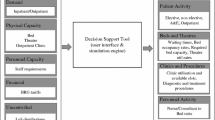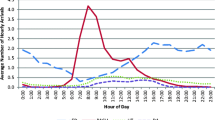Abstract
This research develops a novel data-integrated simulation to evaluate nurse–patient assignments (SIMNA) based on a real data set provided by a northeast Texas hospital. Tree-based models and kernel density estimation (KDE) were utilized to extract important knowledge from the data for the simulation. Classification and Regression Tree models, data mining tools for prediction and classification, were used to develop five tree structures: (a) four classification trees from which transition probabilities for nurse movements are determined, and (b) a regression tree from which the amount of time a nurse spends in a location is predicted based on factors such as the primary diagnosis of a patient and the type of nurse. Kernel density estimation is used to estimate the continuous distribution for the amount of time a nurse spends in a location. Results obtained from SIMNA to evaluate nurse–patient assignments in Medical/Surgical unit I of the northeast Texas hospital are discussed.



Similar content being viewed by others
References
Aickelin U, Dowsland KA (2003) An indirect genetic algorithm for a nurse scheduling problem. Comput Oper Res 31(5):761–778
Aiken LH, Clarke S, Sloane D, Sochalski J, Silber J (2002) Hospital nurse staffing and patient mortality, nurse burnout, and job dissatisfaction. JAMA 288:1987–1993
AONE (2003) Policy statement on mandated staffing ratios. http://www.aone.org/aone/docs/ps_ratios.pdf. Accessed September 2007
Atlason J, Epelman MA, Henderson SG (2004) Call center staffing with simulation and cutting plane methods. Ann Oper Res 127:333–358
Azaiez MN, Sharif SSA (2005) A 0-1 goal programming model for nurse scheduling. Comput Oper Res 32:491–507
Bard J, Purnomo HW (2005) Preference scheduling for nurses using column generation. Eur J Oper Res 164:510–534
Beddoe GR, Petrovic S (2006) Selecting and weighting features using a genetic algorithm in a case-based reasoning approach to personnel rostering. Eur J Oper Res, 175:649–671
Bettonvil B, Kleijnen JPC (1997) Searching for important factors in simulation models with many factors: sequential bifurcation. Eur J Oper Res 96:180–194
Breiman L, Friedman, JH, Oishen RA, Stone CJ (1984) Classification and regression trees. Wadsworth, Belmont, California
Burke EK, Cowling P, Caumaecker PD (2001) A memetic approach to the nurse rostering problem. Appl Intell 15:199–214, special issue on Simulated Evolution and Learning
CDHS (2005) Nurse-to-patient staffing ratio regulations. http://www.dhs.ca.gov/lnc/NTP/default.htm. Accessed January 2006
Ceglowski A, Churilov L (2008) Using self organising feature maps to unravel process complexity in a hospital emergency department: a decision support perspective. Intelligent decision making: an AI-based approach, Springer Berlin, Heidelberg, pp 365–385
Ceglowski A, Churilov L, Wassertheil J (2005) Knowledge discovery through mining emergency department data. In: Proceedings of the 38th annual Hawaii international conference on system sciences, Hawaii, USA
Cheng RCH (1997) Searching for important factors: sequential bifurcation under uncertainty. In: Proceeding of the 1997 winter simulation conference, Piscataway, New Jersey, USA
Dumas MB (1985) Hospital bed utilization: an implemented simulation approach for adjusting and maintaining appropriate levels. Health Serv Res 20:43–61
Epanechnikov VA (1969) Nonparametric estimation of a multivariate probabilty density. Theory Probab Appl 14:153–158
Evans, GW, Gor TB, Unger E (1996) A simulation model for evaluating personnel schedules in a hospital emergency department. In: Proceedings of the 1996 winter simulation conference, Coronado, California, USA
Foster LS, Foster WD (2003) C by discovery. Galgotia, Daryaganj, New Delhi
Fu MC, Hu JQ (1997) Conditional Monte Carlo: gradient estimation and optimization applications. Kluwer, Norwell, Massachusetts
Gutjahr WJ, Rauner MS (2007) An aco algorithm for a dynamic regional nurse-scheduling problem in Austria. Comput Oper Res 34:642–666
Hastie T, Tibshirani R, Friedman JH (2001) The elements of statistical learning: data mining, inference, and prediction. Springer, New York
HIMSS (2006) Himss position statement. http://www.himss.org/content/files/PositionStatements/AdvancedPositionOnMandatedNurseRatio.pdf. Accessed September 2007
HRSA (2002) Projected supply, demand, and shortages of registered nurses: 2000–2020. ftp://ftp.hrsa.gov/bhpr/nationalcenter/rnproject.pdf. Accessed January 2006
INGENIX (2003) ICD-9-CM professional for hospitals: volumes 1, 2 & 3. St. Anthony Publishing/Medicode, Salt Lake City, UT
Jaumard B, Semet F, Vovor T (1998) A generalized linear programming model for nurse scheduling. Eur J Oper Res 107(1):1–18
Jones MC, Marron JS, Sheather SJ (1996) A brief survey of bandwidth selection for density estimation. J Am Stat Assoc 91(433):401–407
Jun JB, Jacbson SH, Swisher JR (1999) Application of discrete event simulation in health care clinics: a survey. J Am Stat Assoc 50(2):109–123
Kim SC, Horowitz I, Young KK, Buckley TA (2000) Flexible bed allocation and performance in the intensive care unit. J Oper Manag 18(4):365–385
Kirkby MP (1997) Moving to computerized schedules: a smooth transition. Nurs Manage 28:42–44
Klein RW, Dittus RS, Roberts SD, Wilson JR (1993) Simulation modeling and health-care decision making. Med Decis Mak 13(4):347–354
Kreke J, Schaefer AJ, Angus D, Bryce C, Roberts M (2002) Incorporating biology into discrete event simulation models of organ allocation. In: Proceedings of the 2002 winter simulation conference, San Diego, California, USA
Lafore R (2000) Object-oriented programming in Turbo C++. Galgotia, Daryaganj, New Delhi
Law AM, Kelton WD (2001) Simulation modeling and analysis. McGrawHill, New York
Lim T, Uyeno D, Vertinsky I (1975) Hospital admission systems: a simulation approach. Simul Games 6:188–201
Miller HE, Pierskalla WP, Rath GJ (1996) Nurse scheduling using mathematical programming. Oper Res 24(5):857–870
Mullinax C, Lawley M (2002) Assigning patients to nurses in neonatal intensive care. J Oper Res Soc 53:25–35
Punnakitikashem P, Rosenberger JM, Behan DF (2008) Stochastic programming for nurse assignment. Comput Optim Appl 40:321–349
Ramon J, Fierens D, Guiza F, Meyfroidt G, Blockeel H, Bruynooghe M, Berghe VDG (2007) Mining data from intensive care patients. Adv Eng Inf 21:243–256
Sheather SJ (2004) Density estimation. Stat Sci 19(4):588–597
Sheather SJ, Jones MC (1991) A reliable data-based bandwidth selection method for kernel density estimation. J R Stat Soc, Ser B 53(3):683–690
Shechter SM, Bryce C, Alagoz O, Kreke JE, Stahl JE, Schaefer AJ, Angus D, Roberts M (2005) A clinically based discrete event simulation of end-stage liver disease and the organ allocation process. Med Decis Mak 25(2):199–209
Shen H, Wan H (2005) Controlled sequential factorial design for simulation factor screening. In: Proceedings of the 2005 winter simulation conference. Orlando, Florida, USA
SHS (2005) Nurse-to-patient staffing ratio regulations. http://iienet2.org/uploadedFiles/SHS/Resource_Library/Details/positionPaper.pdf. Accessed September 2007
Silverman BW (1978) Choosing window width when estimating a density. Biometrika 65(1):1–11
Silverman BW (1986) Density estimation for statistics and data analysis. Chapman and Hall, London
Smith EA, Warner HR (1971) Simulation of a multiphasic screening procedure for hospital admissions. Simulation 17:57–64
Sundaramoorthi D, Chen VCP, Rosenberger JM, Green DFB (2005) Knowledge discovery and mining for nurse activity and patient data. In: Proceedings of the 2005 IIE annual conference, Atlanta, Georgia, USA
Sundaramoorthi D, Chen VCP, Rosenberger JM, Kim SB, Behan DFB (2006) A data-integrated nurse activity simulation model. In: Proceedings of the 2006 winter simulation conference
Sundaramoorthi D, Chen VCP, Rosenberger JM, Kim SB, Behan DFB (2006) Using classification and regression trees for a nurse activity simulation. In: Proceedings of the 2006 IIE annual conference
Vericourt FD, Jennings OB (2006) Nurse-to-patient ratios in hospital staffing: a queuing perspective. http://faculty.fuqua.duke.edu/%7Efdv1/bio/ratios3.pdf. Accessed July 2006
Warner DM (1976) Scheduling nursing personnel according to nursing preferences: a mathematical approach. Oper Res 24:842–856
Zenios SA, Wein LM, Chertow GM (1999) Evidence-based organ allocation. Am J Med 107(1):52–61
Acknowledgements
This research was supported by the Robert Wood Johnson Foundation grant number 053963. We thank Terry Clark from the northeast Texas hospital and Patricia G. Turpin from the School of Nursing at The University of Texas at Arlington, for providing us data for this research.
Author information
Authors and Affiliations
Corresponding author
Rights and permissions
About this article
Cite this article
Sundaramoorthi, D., Chen, V.C.P., Rosenberger, J.M. et al. A data-integrated simulation model to evaluate nurse–patient assignments. Health Care Manag Sci 12, 252–268 (2009). https://doi.org/10.1007/s10729-008-9090-7
Received:
Accepted:
Published:
Issue Date:
DOI: https://doi.org/10.1007/s10729-008-9090-7




